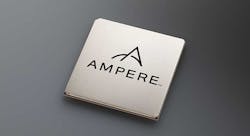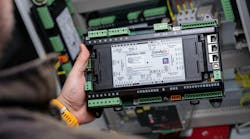Startup Ampere Enters Market for Low-Power ARM Cloud Servers
There’s a new startup in the emerging market for servers powered by low-energy processors from ARM, which are widely used in mobile devices like iPhones and iPads. Ampere is a new company developing ARM-based servers for the fast-growing market for cloud services and hyperscale computing. But ARM enthusiasts will be familiar with its technology, which previously powered the X-Gene server CPUs from Applied Micro.
The company is headed by Renee James, the former president of Intel, who will serve as CEO. The executive team is packed with veterans of Intel, AMD and Applied, and financial backing is provided by The Carlyle Group, a private equity firm with deep pockets and lengthy experience in the data center sector.
Ampere is a “fabless” semiconductor company, meaning it will design and sell chips while outsourcing the fabrication to a specialized manufacturer, in this case TSMC (Taiwan Semiconductor Manufacturing). The company’s initial product is a 64-bit ARM server processor with high memory performance and a low power envelope.
Applied Micro developed the ARM X-Gene microprocessor. In 2016, Applied Micro was acquired by MACOM, which was primarily interested in the company’s networking chips. In October, The Carlyle Group purchased the compute business from MACOM, which received an equity stake in the new company, dubbed Project Denver Holdings at the time. The renamed Ampere is led by James, who joined The Carlyle Group after leaving Intel in 2016 after more than 25 years with the chipmaker.
“We have an opportunity with cloud computing to take a fresh approach with products that are built to addresses the new software ecosystem,” said James. “The workloads moving to the cloud require more memory, and at the same time, customers have stringent requirements for power, size and costs.
“The software that runs the cloud enables Ampere to design with a different point of view,” James said. “The Ampere team’s approach and architecture meets the expectation on performance and power and gives customers the freedom to accelerate the delivery of the most memory-intensive applications and workloads such as AI, big data, storage, database in their next-generation data centers.”
ARM in the Data Center
ARM technology has been ubiquitous in mobile devices but has had a winding path to the data center. In 2010, there were a half dozen companies working to develop ARM servers in a bid to help data centers slash their power bills. Chief among them was Calxeda, which raised $103 million in venture capital, but went out of business in 2013. In the past several years, ARM technology has slowly rebuilt momentum with servers from Cavium, Qualcomm and AMD, but none have made meaningful inroads into Intel’s dominance in the data center, with an estimated server market share north of 95 percent.
The ARM ecosystem got a boost last year when Microsoft announced that it was test-driving ARM cloud servers in its data centers, albeit only for internal workloads and not its public Azure cloud.
Ampere seeks to build on that momentum. It arrives on the scene as the rise of specialized computing is bringing powerful new hardware into the data center, and creating opportunities for hardware startups offering custom silicon for cloud, artificial intelligence (AI), blockchain and the Internet of Things.
“Momentum is building for ARM-based SoCs as an alternative to the insufficient scalability of legacy processors,” said Drew Henry, senior vice president and general manager of the Infrastructure Business Unit at ARM. “Ampere understands this and combines its deep server expertise with a disruptive approach to hyperscale cloud compute.”
The Carlyle Group is familiar to data center veterans for its ownership of One Wilshire and Market Post Tower, the premier carrier hotels in Los Angeles and San Jose. In 2001 it created colocation firm CRG West and began acquiring data center properties across the country. CRG West later changed its name and went public as CoreSite, which is now one of the leading data center REITs.
Carlyle appears to see opportunity in the ongoing disruption in the server sector. Annual spending on servers will reach $15.8 billion by 2021, according to IDC, with cloud providers accounting for $8.3 billion. The cloud server market is experiencing sales growth of 15 percent per year, compared by 3 percent for the broader server market, IDC says. That’s why Ampere is focusing on cloud servers and hyperscale data center operators, who have the sharpest focus on optimizing their operations around compute power, energy use and efficiency.
“That is the highest growth area,” said Kumar Sankaran, Vice President of Software and Platform Engineering, who said ARM servers are now ready for prime time.
“The ARM market has been around for eight years now,” said Sankaran. “It really takes a good eight to 10 years for a market to develop. The software and hardware ecosystems are now at par with x86.”
ARM’s Henry also touted the strength of the ARM ecocystem, which he said “is already accelerating distributed intelligence with the Arm architecture, and building an infrastructure designed to tackle the unprecedented avalanches of data generated by billions, and ultimately trillions, of connected devices.”
Leading With Memory
The company is based in Santa Clara, with operations in Portland, Oregon, Vietnam and India. Ampere is working with Lenovo to integrate its technology into a system on chip (SoC) product.
“We are working closely with Ampere to bring to market a new generation of servers meeting the customized and unique requirements of several of our hyperscale customers,’ said Paul Ju, VP & GM Hyperscale Computing at Lenovo. ”
Ampere CEO Renee James.
Ampere’s chips and SoCs are currently being sampled by a range of cloud providers, said Sankaran, who expects some of them to ramp Ampere into its production servers. The company is working on a next-generation chip that will offer a “quantum leap” in performance improvement within the same energy footprint, Sankaran said. The new chips are expected to be available sometime in 2018, he said.
Ampere processors offer 32 ARM v8 64-bit server operating at up to 3.3 GHz of processing power, with 16 DIMM memory modules offering 1TB of memory at a power envelope of 125 watts. Ampere uses 8x DDR4 memory channels at 2667 MHz, which the company says can offer 33 percent higher capacity and bandwidth than competitors.
“One of the strengths we bring to the table is memory,” said Sankaran. “Current and future workloads are hungry for more memory and bandwidth.” 1TG per socket “makes us sort of the industry leader. That’s an important thing.”
He said Ampere hopes to gain traction with memory-intensive applications such as artificial intelligence, big data, machine learning and databases in the cloud.
Cloud Titans Express Interest
The leading provider of cloud databases said it welcomes the new arrival in the ARM market.
“Ampere’s high memory capacity and bandwidth per socket provides a strong platform for Oracle’s enterprise workloads,” said Edward Screven, Chief Corporate Architect at Oracle. “We look forward to working with Ampere on delivering high-performance solutions to our customers.”
Microsoft, which has become a meaningful player in the ARM market, also expressed interest in Ampere’s work.
“As a new company with a leadership team that has years of experience, Ampere Computing helps increase innovation in the Arm64 server ecosystem, and their roadmap is well aligned with the needs of our hyperscale cloud workloads,” said Dr. Leendert van Doorn, Distinguished Engineer for Microsoft Azure.
In addition to James, Intel veterans on the Ampere team include Chief Architect Atiq Bajwa, Executive VP of Hardware Engineering Rohit Vidwans, and Chief Operating Officer Chi Miller.
Ampere said its technology is “minimally impacted” by recent security vulnerabilities, known as Meltdown and Spectre. The company said the performance impact from patches for Metldown “is very minimal on ARM, especially on this particular version of Arm architecture.” Ampere said architectural changes are being made now to address the ARM fix for Spectre and Meltdown in the company’s next-generation servers.
About the Author



